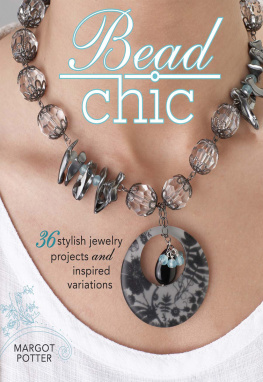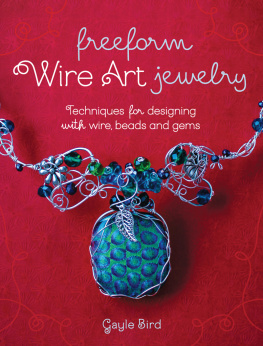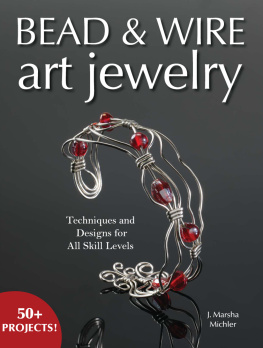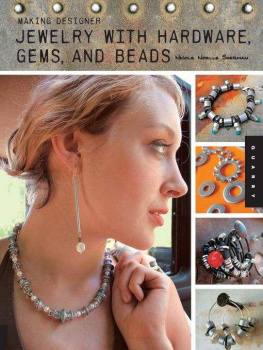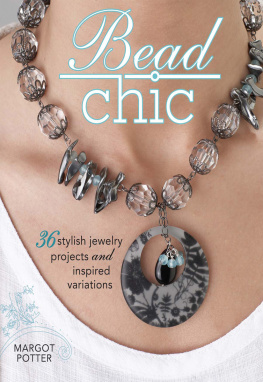MAKING DESIGNER
Bead & Wire Jewelry
Techniques for Creating Unique Designs and Handmade Findings
Tammy Powley

2005, 2011 by Quarry Books
All rights reserved. No part of this book may be reproduced in any form without written permission of the copyright owners. All images in this book have been reproduced with the knowledge and prior consent of the artists concerned and no responsibility is accepted by producer, publisher, or printer for any infringement of copyright or otherwise, arising from the contents of this publication. Every effort has been made to ensure that credits accurately comply with information supplied.
First published in the United States of America by:
Quarry Books, a member of
Quayside Publishing Group
100 Cummings Center
Suite 406-L
Beverly, Massachusetts 01915-6101
Telephone: (978) 282-9590
Fax: (978) 283-2742
www.quarrybooks.com
Digital edition: 978-1-6167-3791-7
Softcover edition: 978-1-5925-3166-0
Library of Congress Cataloging-in-Publication Data
Powley, Tammy.
Making designer bead and wire jewelry : techniques for creating unique designs
and handmade findings /Tammy Powley.
p. cm.
ISBN 1-59253-166-0
1. Beadwork. 2. Jewelry making. I. Title.
TT860.P696 2005
745.594'2dc22 2004025741
CIP
ISBN-13: 978-1-59253-166-0
ISBN-10: 1-59253-166-0
15 14 13 12 11 10 9 8
Design: Terry Patton Rhoads
All photos by Allan Penn
Illustrations by Judy Love
Printed in Singapore
CONTENTS
INTRODUCTION
Wire is one of the most versatile components used in jewelry making, and when combined with beads, the design possibilities dramatically increase. Common wire and bead techniques, such as making a bead and wire chain or threading wire through a single bead to make a bead-dangle, are usually part of the average jewelry designers repertoire. However, you dont need to stop there; wire can allow you to do much more when it comes to expanding your jewelry-making skills. Creating wire findings, including ear hooks, headpins, and clasps, is one way to add another layer to your jewelry art, often enabling you to make each component of your finished piece.
Although the instructions in this book are intended to increase your potential for producing signature jewelry elements, all levels of jewelry makers, from the inexperienced beginner to the more seasoned craftperson, will find it a valuable resource. If you have never worked with beads or wire, dont be intimidated by the potential of creating each component. With practice and guidance from the projects in this book, youll be amazed at what you can accomplish. For those who have already made numerous pieces of jewelry, you too will find inspiration and new ideas to broaden your abilities.
One reason for this books wide range of design options is the generous techniques section, which provides step-by-step, illustrated instructions covering basic finishing methods along with detailed directions on using wire to construct your own findings. Building on the techniques section, the projects in this book offer you specific examples to follow so that you can then combine these methods and create unique pieces of finished jewelry. Throughout, youll receive helpful jewelers tips and design advice to assist you in constructing quality jewelry you will be proud to wear and give as gifts. Finally, each jewelry project also includes a variation, demonstrating alternative designs using the same basic elements. As you learn to master the techniques, youll soon realize that each works as a continuation of the next, ultimately building your skill level until you are soon comfortable making every piece of your design.
ABOUT BEADS

If you already make beaded jewelry, then you are probably familiar with the addictive nature of beads. For those uninitiated into the world of beads, prepare yourself. One bead purchase inevitably leads to the next, and the next, and so on, until you find that youve become a bead-a-holic. However, the good news is that because there are so many types of beads available, they can inspire you to create a plethora of designs, from the classic to the exotic.
Although the huge variety of available beads can be daunting, it can be exciting as well. Beads are not just ornamental objects; they are significant artifacts that share a rich history throughout time, and you instantly become part of this history with the allocation of your first bead.
TYPES OF BEADS
Just about any item with a hole in it is a possible bead. Therefore, to attempt to list and describe every type of bead in existence would require more than just a few pages of text. Following is a list and brief description of some of the most common types of beads used for designing jewelry.
Gemstones

Extremely popular, gemstone beads come in a large variety of stones, shapes, and sizes.
Precious: Rubies, emeralds, sapphires, and diamonds are called precious gemstones because of their limited availability. Although you most often see precious gemstones used in fine jewelry, such as diamond rings and ruby ear studs, these stones are also available in the form of beads. As you can imagine, the price for precious gemstone beads is comparative to their fine jewelry relatives. However, imagine a beautiful necklace made with ruby beads!
Semiprecious: Because these stones are more readily available than precious gemstones, they are also more affordable. They come in a wide variety of stones, from agate to zoizite. Most beaders are big fans of semiprecious gemstone beads because they allow you to create high-quality jewelry using natural elements from the earth. If you are a lover of stone beads, make sure you take a look at my book Making Designer Gemstone and Pearl Jewelry for more information about gemstones and how to use them in your jewelry creations.
Organic: Although they are not made of stone, organic beads, such as pearls and amber, are sometimes included under the gemstone category. For more information on organic beads, refer to the Natural Materials section.
Natural Materials
Along with gemstones, there are many other naturally occurring materials used in beading.






